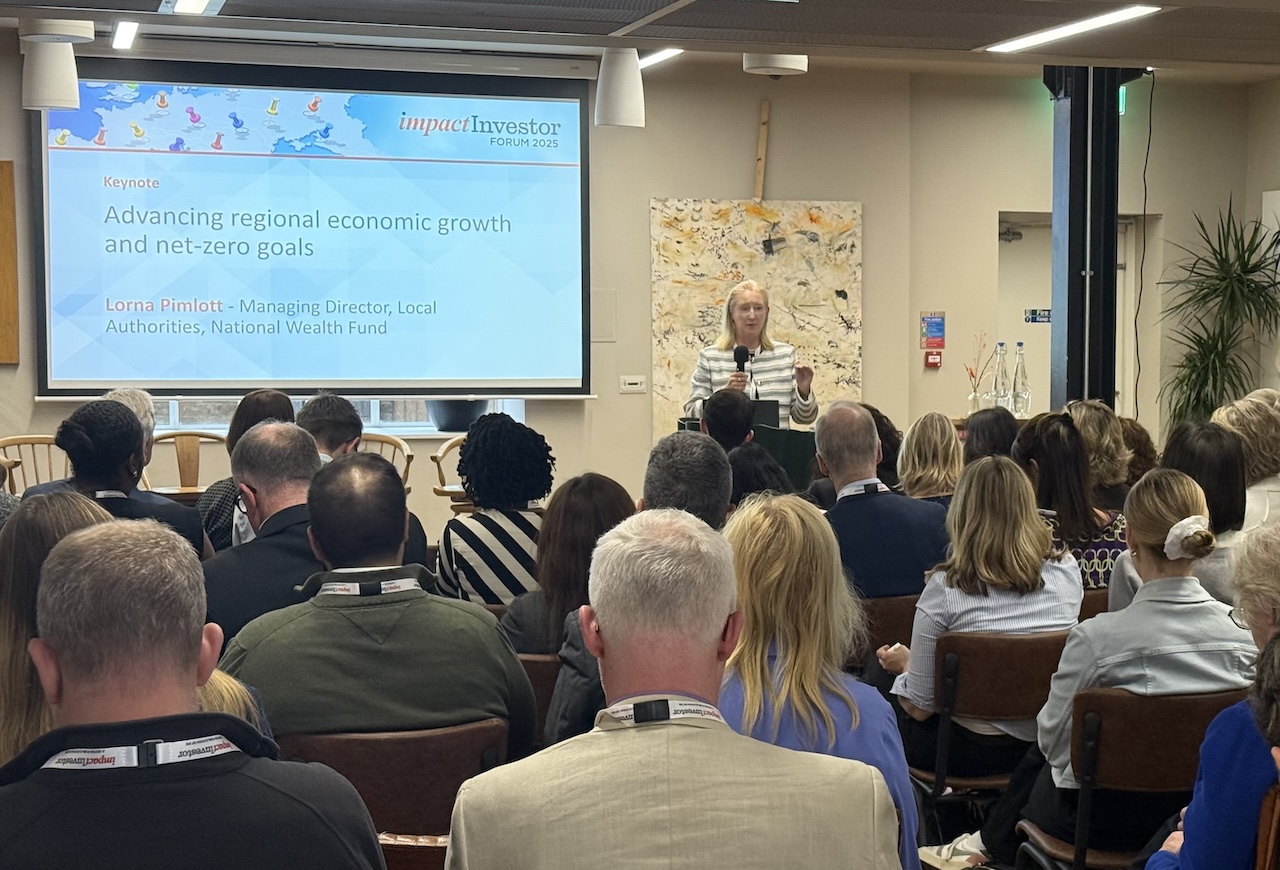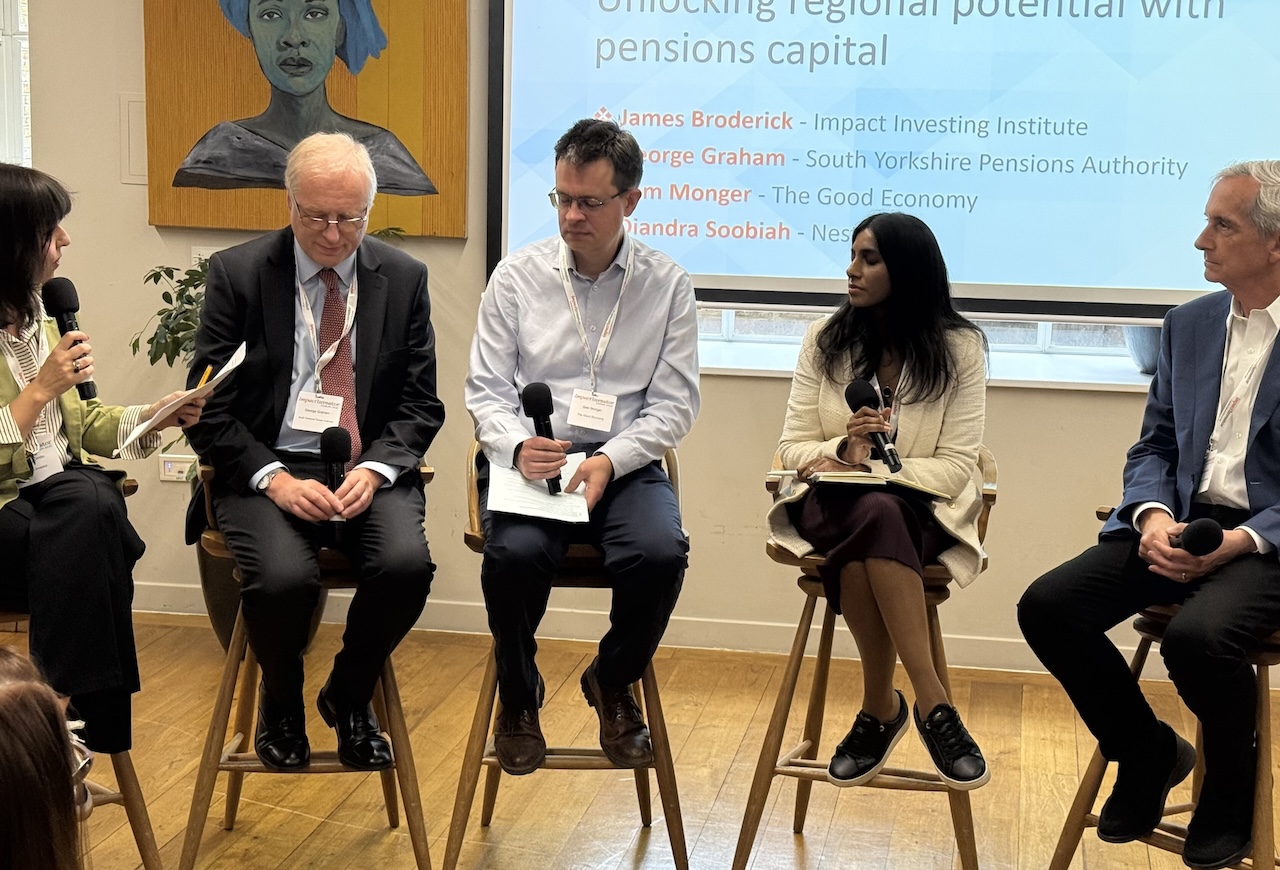Asset owners and market practitioners came together at last week’s Impact Investor Forum to debate how place-based investing is changing the landscape for investors and communities.

Place-based investing strategies are emerging as powerful tools for driving growth, climate resilience, and social progress, particularly in the UK, where institutional allocations have increased substantially.
Last week, asset owners, market experts and practitioners came together at the Impact Investor Forum in London to discuss how place-based investing can be a powerful tool to drive sustainable and inclusive economic growth.
Lorna Pimlott, managing director, local authorities, at the National Wealth Fund (NWF), opened the event with an overview of the organisation’s work directing capital to local and regional projects that support the UK government’s ambitions for economic growth and the net-zero transition.
“It’s been quite a journey,” said Pimlott, reflecting on the organisation’s transition from the former UK Infrastructure Bank in October last year – a shift that expanded its mandate beyond infrastructure to align with the government’s broader industrial strategy, working closely with local authorities and the private sector.
NWF has £27.8bn (€33bn) to help crowd in private investment and drive growth across the UK. Since its inception in 2021, the organisation has deployed £6bn of capital across 52 deals.
“Mostly what we focus on is the commercial viability of the projects in the first place. We look at the options that [local authorities] have looked at for finance and most importantly, their allocation of risk,” she added, explaining that NWF takes four times the level of risk of a commercial bank.
“We have an increased capacity for risk. Where others will not go, we need to go early to make the projects happen,” said Pimlott. “Our role is to crowd in, not to crowd out. To be at the table when others are not. If a project can get the finance anywhere else they should do that,” said Pimlott, giving the example of two recent carbon capture projects involving the NWF where it stepped aside at the eleventh hour to make space for private investment.
“We were able to reassure the private sector. If we are not needed in the end, that is a real mark of success for us. It means we can use our finance for other projects, and more nascent technologies where fewer private investors want to go,” she added.
Pensions capital
During a panel discussion on the role of pensions funds in driving regional growth, panellists explored the current scale and structure of the place-based investing sector, the role of government and the practical challenges of investing through a place-based lens, as well as the benefits that pension fund members can gain from local economic development, such as affordable housing, clean energy, and job creation.

George Graham, director of the South Yorkshire Pensions Authority (SYPA), told attendees that members want them to invest in ways which will promote growth in their local area.
SYPA, which oversees £11bn assets under management, has an allocation to local investments that has evolved into a place-based impact investment strategy focused on both UK-wide strategies, such as a homelessness-focused investment fund, along with wider regional investments, regeneration projects, and small and medium-sized enterprise (SME) financing.
“Back in 2019 we agreed on a local investment allocation, which has since evolved into a place-based impact investment portfolio, which has an allocation target of 5%,” he said.
In March, SYPA announced two new £20m investment funds to support SMEs across South Yorkshire.
Graham stressed the importance of focusing on investments that benefit the local ecosystem, while maintaining independence from political agendas. “Local government pension funds don’t like being told by the government what they should invest in, we tend to react badly to that,” Graham said.
“My job isn’t to promote the economy of South Yorkshire. My job is to pay pensions,” he said, adding he believes they can do both things at the same time. Graham explained SYPA has recently signed a memorandum of understanding with the South Yorkshire Mayoral Combined Authority, focused on how they will work together on investible projects.
Diandra Soobiah, director of responsible investment & ESG integration at £48bn Nest, said the workplace pension provider has plans to invest up to 30% of its assets in the UK by 2030. Nest was one of the 17 defined contribution (DC) pension schemes who signed Mansion House Accord last week, committing to increase allocations to private market investments.
Intentionality
As Nest grows its UK portfolio, it is also strengthening its focus on intentionality and social impact. “We will be taking a much broader impact lens and looking at more intentionality in the UK, and looking at how that we can bring benefits to our members.” Soobiah added: “I think we are going to be talking to our fund managers a lot more about being much more explicit in their objectives for intentionality.”
Jamie Broderick, deputy chair at the Impact Investing Institute, reflected on the meaning of ‘local’ versus ‘place-based’ when it comes to investing. He said: “The point I’d really like to make is that we use local as a shorthand. But local investing isn’t place-based investing. Place-based investing is about doing an investment that responds to the needs, priorities and strategies of a local community, however you define that. And so you can have an investment that’s in a place – and, frankly, most private market investments are in a place – that doesn’t actually respond to that.”
Sam Monger, head of place-based impact investing and strategic advisory at The Good Economy, agreed: “You could talk about investing in things in your location, but are you actually doing it with the purpose to drive better outcomes for the local community?”
The Good Economy will soon be publishing a white paper looking at the current state of place-based investing in the UK, an update on their 2021 paper which found that half of the local government pension schemes surveyed were doing some kind of place-based investing, but “only six had a really intentional approach to it”.
Inclusive growth
Place-based investing has the potential to create more inclusion, said speakers in the afternoon’s second panel discussion, focused on inclusive growth and steps towards building a more sustainable and equitable society.
Discussions highlighted the vital role investors can play in ensuring that vulnerable communities are part of the conversation around local investment strategies.

Panellists explored how investors can incorporate local voices into their decision-making processes, and how impacts are being measured.
Laasya Shekaran, director of Pensions for Purpose said that place-based investing is gaining traction among institutional investors. “It is an area that’s getting a lot of focus from different types of pension funds at the moment. Local government pension funds and pools obviously have an intrinsic interest there, but also other investors that are looking to make an impact get a diversified source of returns, and generate the usual financial returns they need,” Shekaran said.
Anna Shiel, CIO at Better Society Capital, said that growth in local investing will also be driven by climate concerns. “The just transition to net zero is going to require an inherently place-based approach that needs to be tackled in every place,” she said.
Investors on the panel approached place-based allocations and inclusion through different but similar lenses.
“We look at gaps in the provision of capital, and gaps in the provision of services,” said Vanessa Morphet, head of social impact at the Church of England, which has a £25m social impact investment programme.
Some of the challenges surrounding place-based investing evolve around communications, and gaining the trust of local communities, the panel said.
“We miss a trick in pensions by not being good at just telling that straight impact story,” said Sally Bridgeland, chair of Brunel Pensions Partnership and the Development Bank of Wales.
For her part, Shiel emphasised the important role of fund managers can play in bridging the needs of local communities and the needs of investors. “Fund managers are going out and finding opportunities that others may not see, and might overlook, building an understanding of what local communities need.”
Most investors have a clear fiduciary duty that means they need to deliver a certain level of returns, so finding investments that fit their financial characteristics as well as the right scale can be challenging, especially in a world of greater pension sector consolidation, according to the panel.
“The move of more being done by the pools versus the funds exacerbates that problem. So that’s something we’re definitely grappling with,” said Shekaran.
Government policy and industrial strategy can help mitigate some of the risks for investors, according to Bridgeland. “If you’ve got that alignment of national [policy] and local political influence generally, then the whole investment is much more attractive.”
Measuring impact
The best way investors can assess how well impact is being delivered is to use metrics that really reflect how local communities are benefitting, according to Morphet.
“If it’s SME finance, it’s local jobs…where were they created, who’s being able to access those? If it’s housing, how affordable is that really in the local context? And how does that relate to median incomes that are measured in the global community context? It is about making sure that those metrics are really thinking about place,” Morphet said.
Bridgeland added that she would like to see a “net promoter score” that shows investors why people think their area is a great place to live. “We’re missing a trick in getting those kind of measures, the positive things about how people feel about an area,” Bridgeland said.
Infrastructure and natural capital
Other speakers spoke about place-based investing in a broader context. Joe Robinson, director, ESG and sustainability at Equitix, talked about the role that infrastructure assets play in offering solutions to local, national and global sustainability challenges, and the importance of institutional investors being able to see how their allocations work in practice.
“I think there’s something immensely powerful about explaining to a trustee of a pension scheme or a charity or even a sovereign wealth fund, what it is that their assets are actually doing in the real economy and that their allocation of capital is making available an asset that is of critical use to society in some form,” he said.
Kim Foley, associate director for investor relations at New Forests, extended the scope of the event beyond the UK to discuss ways to maximise the impact nature-based investments on local communities in both developed and developing countries.
“Often our investments are in rural areas where the local community really depends on the work that is done in terms of forestry and other natural capital activities,” she said.





